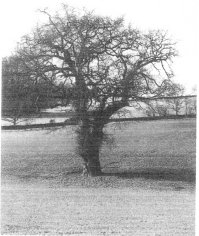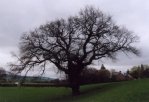 |
The Reverend
John Walker, or the `Mad Minister of Moffat"
as he was known, was minister in Moffat from 1762
- 1783.
His reputation for eccentricity stemmed from the fact
that he carried seedlings in a pouch on his person
and, wherever he went, planted them by the wayside
and in other suitable spots.
He planted an Umbrella Fir near an existing oak tree,
which stood at the bottom of the hillside on the west
side of the River Annan, near the bridge at the Station
Park. And because of the way it was transported, the
Umbrella Fir became known as the Pouch Tree.
As the Rev. John planted his young fir, he remarked
to the mature oak tree - the Gowk tree - that it would
still be standing after his Umbrella Fir was long
gone. His words rang true as the Gowk Tree can still
be seen over two centuries later.
The Gowk Tree was so called because it was a favoured
calling post for the summer residing cuckoo (gowk
is an old Scots word for cuckoo).
|
The
Gowk Tree
The Oak apparently
stood in full view of the Kirk Manse and was noted as always
being the tree where the Cuckoo was first heard calling
each year and it is from this that the tree gained its name.
Legend has it that, when the other trees were being felled,
the Gowk Tree was individually bought by Rev.Walker to preserve
it. A good investment as still survives well over two centuries
later!
Some further
details have come to light -
From the Dumfries & Galloway Natural History & Antiquarian
Society annals of 1891-1892, it would appear that the Gowk
Tree was measured as having a girth of 12ft 5in at a height
of 1ft 3in above ground level and a girth of 10ft 4in at
a height of 5ft 9in above ground. It was then estimated
as being 230-250 years old. These annals also mention the
Pouch Tree (see below).
As you leave
Moffat on the road towards the motorway, look into the field
on your right just after crossing the bridge at Station
Park. The 'Gowk Tree' still stands there in all its splendour.
If, as mentioned above, it was a 'mature' oak in Reverend
Walker's time, then it must be some 300 years (or more)
old by now. Oh, the sights it has seen and the tales it
could tell!
Jock Dicerbo
has kindly made available some photographs of the Gowk Tree
in each of the four seasons -

Spring
the oak is later than most incoming
into leaf |

Summer
sheep appreciating the cool shade from
the sun |

Autumn
a glorious display of autumn colours |

Winter
a wonderfully tranquil snow scene |
And there is
an old, emotive poem written about it -
The
Auld ' Gowk 'Tree'
Thou
rare auld oak with massive trunk and arms thrown out around
Thy bushy head with foliage dense o'ershades a rood of ground
Thy heart within is sound and tight as heart of oak should
be
And the landscape's pride and boast is just, the Auld Gowk
Tree.
The
oldest residenter whose boyish lore began
When the auld kirk was a building and the 'Roaring Dilly'
ran
Marks scarce a change upon thee and as twice as old as he
Would have found thee still at memory's dawn, the Auld Gowk
Tree
When
a century syne the bank was cleared on which thou stand'st
alone
And lots of kin and neighbours fell, their fate had been thine
own.
But Dr. Walker, good old soul, true friend and worth of thee,
Shell' d out to save from axe and saw, the Auld Gowk Tree.
Some
say the ransom was a pound, some say 'twas half-a-crown
But gold or silver, sure enough, his reverence paid it down
And like the green bay flourishing and fresh his memory be
Who saved our richest sylvan gem, the Auld Gowk Tree.
Tho'
now thou'rt standing all alone 'tis princely solitude,
With glorious sylvan guard at hand, the choice of Scottish
wood.
They grace the broad hill's swelling side in line and column
free
And shield from tattering wild west winds, the Auld Gowk Tree.
Thou
monarch of our woodland hosts, where shall we find thy peer?
The Umbrella Fir, though rare and grand, and verdant a' the
year
'Twas but a twig about as big as thistle on the lea
When thou as now, vast trunk and bow, the Auld Gowk Tree.
It's
now some twenty winters sin' the wind wi' deadly twist
Tore off a stately branch of thine, the goodliest on the list.
Though stock enough to furnish out a grove of fair degree
Ye wad scarce jalouse the loss o't in the Auld Gowk Tree.
The
gentle ' Annan' murmurs near in summer's limpid flow
And Moffat roofs and, spires shine out in noon's resplendent
glow
The lounger on the brig below for a' that tak' s his e'e,
Has aye a sidelong glance to send the Auld Gowk Tree.
When
woods are buskit fresh in a' the flush of leafy june
And thickets ring with gleesome birds the leelang afternoon
While's like a ranting chorus to the jovial minstrelsie,
The 'gowk' himsel' comes in 'Cuckoo'; f'rae his ain auld tree.
In
Moffat walks there's ash and elm and mony a glossy beech
Their whispering leaves just sound at eve like kindly, hamely
speech
But which o' them, though tall and fair can stir the heart
like thee
Or wake such tender memories, as the Auld Gowk Tree.
Long may'st
thou stand in veteran might unscathed by bolt or blast
The emblem of a grand old age, still glorious to the last
And Moffat's bards a century hence rejoice to sing of
thee
The chieftain of her sylvan race, her Auld 'Gowk Tree'....
Notes
-
1) the 'Roaring Dilly' mentioned in the second verse was
a stagecoach
2) the 'auld kirk' was demolished circa 1790



